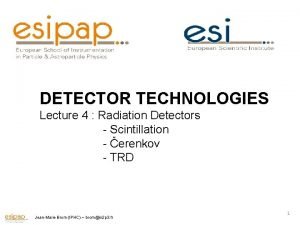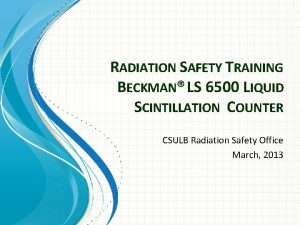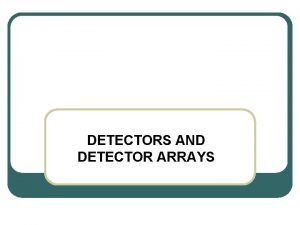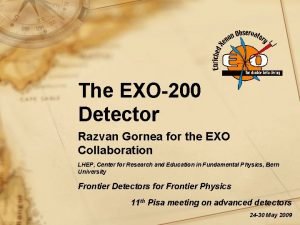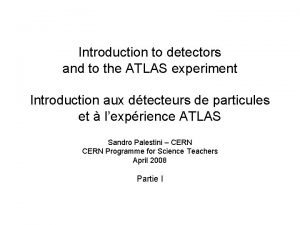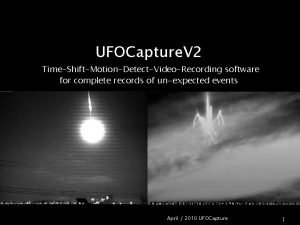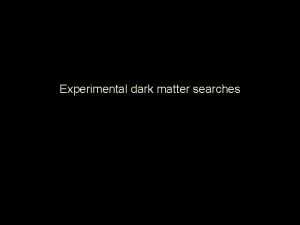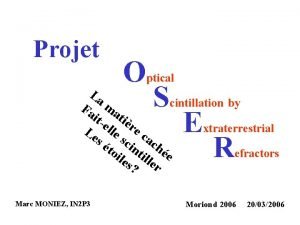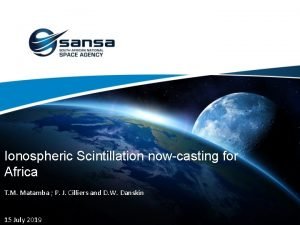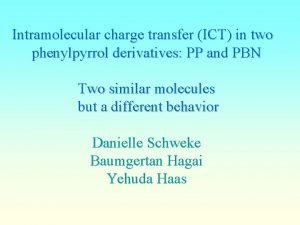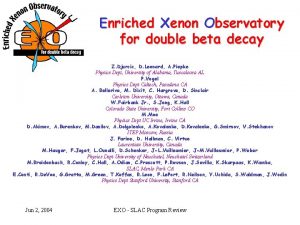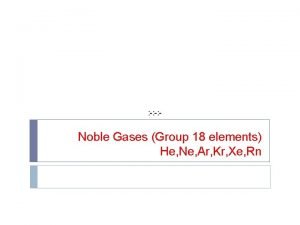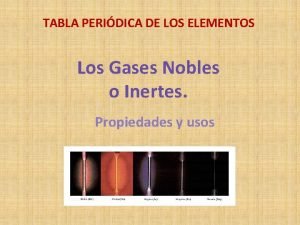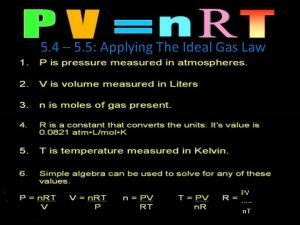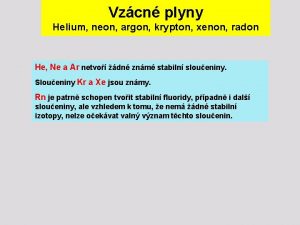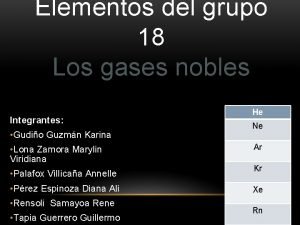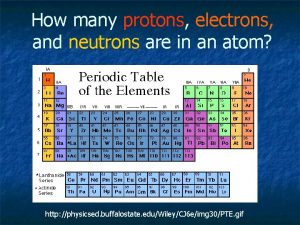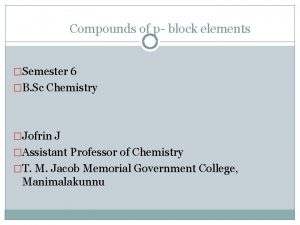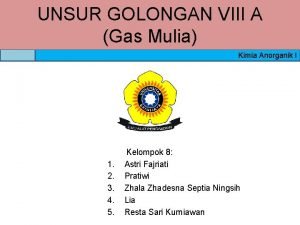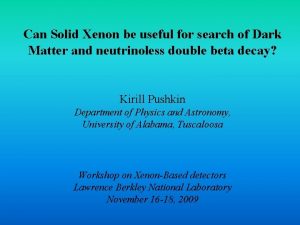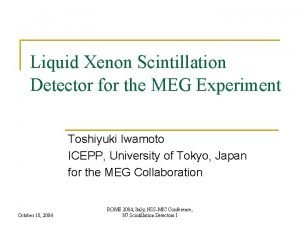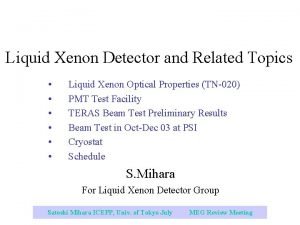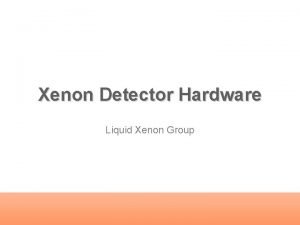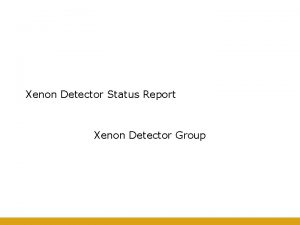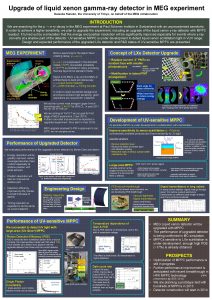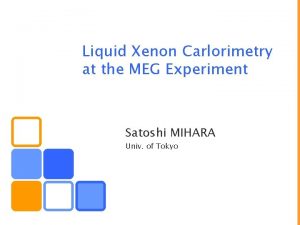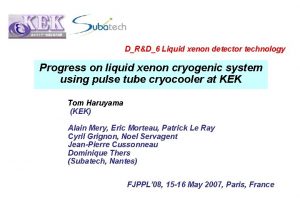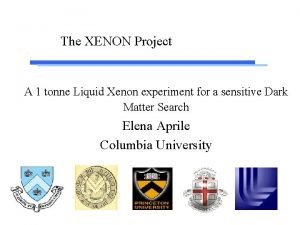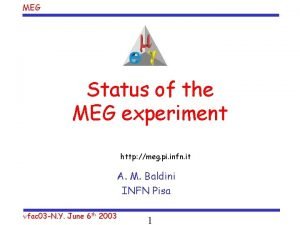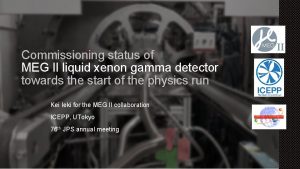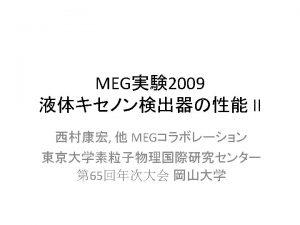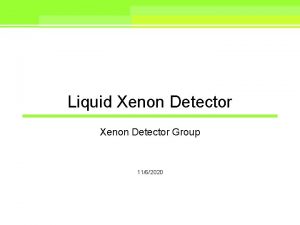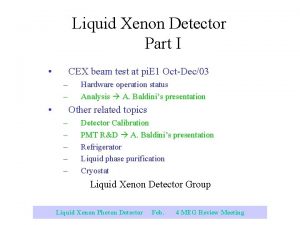Liquid Xenon Scintillation Detector for the MEG Experiment
























- Slides: 24

Liquid Xenon Scintillation Detector for the MEG Experiment Toshiyuki Iwamoto ICEPP, University of Tokyo, Japan for the MEG Collaboration October 18, 2004 ROME 2004, Italy, NSS-MIC Conference, N 7 Scintillation Detectors I

Contents n n n Motivation & Event Signature MEG Experiment & Detector Photon Detector TERAS Beam test p 0 beam test in PSI Summary October 18, 2004 ROME 2004, Italy, NSS-MIC Conference, N 7 Scintillation Detectors I

Motivation & Event Signature m->eg branching ratio Present limit: 1. 2 x 10 -11 Ø LFV process Ø Forbidden in the SM Ø Sensitive to SUSY-GUT, SUSY-seesaw etc. Ø Our goal : Br(m->eg)>10 -13~10 -14 Clear 2 -body kinematics 52. 8 Me. V 180° 52. 8 Me. V Michel decay (μ+→e+νeνμ) + random γ Background Rate ~ 10 -14 Radiative muon decay (μ+→e+νeνμγ) Background Rate < 10 -14 October 18, 2004 Only allowed after Kam. LAND ROME 2004, Italy, NSS-MIC Conference, N 7 Scintillation Detectors I

MEG Experiment & Detector Approved in 1999, at Paul Scherrer Institut, in Switzerland Physics run in 2006 Initial goal at 10 -13, finally to 10 -14 COBRA Xe Detector 252 cm Timing Counter m+ beam : World’s most intense DC Beam 108 m+ /s g detector : 800 liter liquid xenon scintillation detector with 830 PMTs e+ detector : m+ solenoidal magnetic spectrometer with a gradient magnetic field (COBRA) October 18, 2004 262 cm Drift Chamber ROME 2004, Italy, NSS-MIC Conference, N 7 Scintillation Detectors I

The MEG Collaboration ICEPP, University of Tokyo Y. Hisamatsu, T. Iwamoto, T. Mashimo, S. Mihara, T. Mori, H. Nishiguchi, W. Ootani, K. Ozone, T. Saeki, R. Sawada, S. Yamashita KEK, Tsukuba T. Haruyama, A. Maki, Y. Makida, A. Yamamoto, K. Yoshimura, K. Kasami Osaka University Y. Kuno Waseda University T. Doke, J. Kikuchi, S. Suzuki, K. Terasawa, A. Yamaguchi, T. Yoshimura INFN & Genova University S. Dussoni, F. Gatti, D. Pergolesi, R. Valle INFN & Lecce University S. Spagnolo, C. Chiri, P. Creti, M. Panareo, G. Palama’ INFN & Pavia University A. de Bari, P. Cattaneo, G. Cecchet, G. Nardo’, M. Rossella INFN & Pisa University A. Baldini, C. Bemporad, F. Cei, M. Grassi, F. Morsani, D. Nicolo’, R. Pazzi, F. Raffaelli, F. Sergiampietri, G. Signorelli INFN Roma I D. Zanello PSI, Villigen J. Egger, P. Kettle, M. Hildebrandt, S. Ritt Budker Institute, Novosibirsk L. M. Barkov, A. A. Grebenuk, D. G. Grigoriev, B, Khazin, N. M. Ryskulov October 18, 2004 ROME 2004, Italy, NSS-MIC Conference, N 7 Scintillation Detectors I

Photon Detector Ø 800 liter liquid xenon scintillation detector 830 PMTs directly filled into the liquid (effective coverage ~ 35%) ØHigh light yield (75% of Na. I(Tl) ), fast response (decay time ~4 ns) and good uniformity The strategy of R&D u Small prototype ( 2. 3 liter size ) ~Me. V region study with sources u Large prototype ( 68. 6 liter size ) 1. TERAS beam test energy resolution of 10~40 Me. V g timing and vertex resolution 2. p 0 beam test in PSI energy resolution of 53~129 Me. V g October 18, 2004 ROME 2004, Italy, NSS-MIC Conference, N 7 Scintillation Detectors I Liq. Xe g

Large Prototype Detector Large Prototype Smaller acceptance Xe detector Active volume : 68. 6 liter 228 2” PMTs (Hamamatsu R 6041 Q) To check performances and LN 2 free operation by cryocooler October 18, 2004 ROME 2004, Italy, NSS-MIC Conference, N 7 Scintillation Detectors I

1. TERAS Beam Test 40 Me. V g Energy Inverse Compton g Energy : 10, 20, 40 Me. V Incident Position : Detector Center Estimate Energy Resolution using Compton Edge 40 Me. V g Vertex distribution 1. 6% in s 3. 8 mm in s October 18, 2004 ROME 2004, Italy, NSS-MIC Conference, N 7 Scintillation Detectors I

0 p 0(28 Me. V/c) -> g + g Opening angle selection of two g’s monochromatic g 80 Me. V 55 Me. V - Energy (Me. V) 0 Beam Test at PSI p Concept p (at rest) + p -> p + n, 175° 170° 155° Opening angle (deg) 54. 9 Me. V 82. 9 Me. V Liquid H 2 Target October 18, 2004 ROME 2004, Italy, NSS-MIC Conference, N 7 Scintillation Detectors I Energy (Me. V) 180°

p 0 Beam Test at PSIXe l p- (at rest) + p -> p 0 + n, LP p 0(28 Me. V/c) -> g + g monochromatic g calibration of around 52. 8 Me. V l p- + p -> n(8. 9 Me. V) + g (129 Me. V) linearity check & neutron response 115 cm n 115 cm g 8 x 8 Na. I LP Xe total charge p-p->np 0, p 0 ->2 g pp-p->ng To get Energy Resolution Select p 0 events Select Na. I energy Select incident position in Xe detector Remove too shallow and too deep events Na. I Energy (Me. V) October 18, 2004 ROME 2004, Italy, NSS-MIC Conference, N 7 Scintillation Detectors I

Energy Resolution Energy resolution in right s(%) 5. 0 4. 0 preliminary 3. 0 TERAS data PSI data 2. 0 4. 5% FWHM 1. 0 Energy spectrum @ 54. 9 Me. V g FWHM = (4. 5± 0. 3)% s (right)=(1. 6± 0. 1)% This result satisfied our requirement October 18, 2004 Right s is a good function of energy photon statistics are still dominant, further improvement is expected by ~ 3 x. Q. E. PMT(R 9288) ROME 2004, Italy, NSS-MIC Conference, N 7 Scintillation Detectors I

Neutron Response in Large Prototype LP Xe total charge E(Na. I)>100 Me. V, Qsum<20000 p-p->np 0, p 0 ->2 g p-p->ng Xe detector response for 8. 9 Me. V neutron ~30 ns LP Xe TDC timing (ns) Neutron TOF ~ 30 ns (115 cm/0. 14 c) Neutron Kenergy=8. 9 Me. V No bias data for Xe Require the beam correlation October 18, 2004 It might be the first time to detect the fast neutron like 8. 9 Me. V in such a large scale Xe detector. 45% detection efficiency @0 Me. V th. 30% @1 Me. V th. ROME 2004, Italy, NSS-MIC Conference, N 7 Scintillation Detectors I

Summary n n n MEG experiment will search for m->eg decay, to explore SUSY-GUT, and currently being prepared at Paul Scherrer Institut in Switzerland. Large prototype of the xenon detector has been tested from 10 Me. V to 129 Me. V, and the excellent energy resolution at around 52. 8 Me. V was shown in the PSI beam test. Physics run will start in 2006. October 18, 2004 ROME 2004, Italy, NSS-MIC Conference, N 7 Scintillation Detectors I

End of Transparency October 18, 2004 ROME 2004, Italy, NSS-MIC Conference, N 7 Scintillation Detectors I

How much water contamination? Simulated data Measured/MC Before purification: ~10 ppm After purification: ~10 ppb October 18, 2004 ROME 2004, Italy, NSS-MIC Conference, N 7 Scintillation Detectors I

Measured / MC(abs=inf. ) MC(abs=var. ) / MC(abs=inf. ) Absorption length estimation simulated data measured a data/simulated a data Comparing the two results, the absorption length is estimated to be over 3 m (97. 8% C. L. ). October 18, 2004 ROME 2004, Italy, NSS-MIC Conference, N 7 Scintillation Detectors I

PMT (HAMAMATSU R 6041 Q) 32 mm Features l 2. 5 -mmt quartz window l Q. E. : 6% in LXe (TYP) (includes collection eff. ) l Collection eff. : 79% (TYP) l 3 -atm pressure proof l Gain: 106 (900 V supplied TYP) l Metal Channel Dynode thin and compact l TTS: 750 psec (TYP) l Works stably within a fluctuation of 0. 5 % at 165 K October 18, 2004 ROME 2004, Italy, NSS-MIC Conference, N 7 Scintillation Detectors I 57 mm

Motivation ØUnder high rate background, PMT output (old Type PMT, R 6041 Q) reduced by 10 -20%. ØThis output deterioration has a time constant (order of 10 min. ): Related to the characteristics of photocathode whose surface resistance increases at low temperature. ØRb-Sc-Sb + Mn layer used in R 6041 Q ØNot easy to obtain “high” gain. Need more alkali for higher gain. ØLarger fraction of alkali changes the characteristic of PC at low temp. So, New Type PMTs, R 9288 (TB series) were tested under high rate background environment. ØK-Sc-Sb + Al strip used in R 9288 ØAl strip, instead of Mn layer, to fit with the dynode pattern Confirmed stable output. ( Reported in last BVR) But slight reduction of output in very high rate BG Al Strip Pattern ØLow surface resistance Add more Al Strip R 9288 ZA series ROME 2004, Italy, NSS-MIC Conference, October 18, 2004 Yasuko HISAMATSU N 7 MEG VRVS Meeting @PSI June 2004 Scintillation Detectors I

Works on Design of PMT Two Issues to be solved: 1. Output deterioration caused by high rate background. (Effects of ambient temperature on Photocathode ) Ans. Reduce Surface Resistance by adding Aluminum Strip Pattern Delivered from HPK in April Rate Dependence Test @ Liq. Xe 2. Shortage of Bleeder Circuit Current Ans. Improve Design of the Circuit by adding Zener Diode HPK has started to work on new bleeder circuit design October 18, 2004 ROME 2004, Italy, NSS-MIC Yasuko HISAMATSU MEG VRVS Meeting. Conference, @PSI June 2004 N 7 Scintillation Detectors I

Large Power Pulse Tube Cryocooler Technology transfered to Iwatani Co. , Ltd Designed: 150 W @165 K October 18, 2004 ROME 2004, Italy, NSS-MIC Conference, N 7 Scintillation Detectors I

Purification System n n n Xenon extracted from the chamber is purified by passing through the getter. Purified xenon is returned to the chamber and liquefied again. Circulation speed 56 cc/minute • Enomoto Micro Pump MX-808 ST-S – 25 liter/m – Teflon, SUS Gas return To purifier Circulation pump October 18, 2004 ROME 2004, Italy, NSS-MIC Conference, N 7 Scintillation Detectors I

Beam Line target 590 Me. V proton m+/e+ separator m+ Beam Transport Solenoid beam line MEG Detector Bending magnet Degrader Quadruple magnets Surface muon beam : 28 Me. V/c Beam line design established World’s most intensive m+ beam: 107~8/s October 18, 2004 ROME 2004, Italy, NSS-MIC Conference, N 7 Scintillation Detectors I

COBRA Spectrometer COBRA magnet was already installed into the p. E 5 area in PSI. Constant bending radius independent of the emission angle e+ momentum easily used at trigger level Michel positrons are quickly swept out reduce the hit rate for stable operation October 18, 2004 ROME 2004, Italy, NSS-MIC Conference, N 7 Scintillation Detectors I

Signal & Background n Single event sensitivity Nm~2. 5 x 107/s, T=2. 6 x 107 s, W/4 p =0. 09, eg=0. 6, ee=0. 9 Sensitivity (m ->eg) ~ 4. 5 x 10 -14 (1 st phase, capable to Nm~1 x 108/s) n Background Accidental : Michel decay (μ+→e+νeνμ) + random γ Background Rate ~ 10 -14 Radiative muon decays : μ+→e+νeνμγ Background Rate < 10 -14 n Expected detector resolution DEg : 4. 5% (FWHM) DEe : 0. 8% (FWHM) Dqeg : <19 mrad (FWHM) Dt eg : <230 ps (FWHM) Good energy, time and position resolutions are required for g, e+ detector. October 18, 2004 ROME 2004, Italy, NSS-MIC Conference, N 7 Scintillation Detectors I
 Scintillation detector technologies
Scintillation detector technologies Beckman ls6500 liquid scintillation counter
Beckman ls6500 liquid scintillation counter Xenon gas detector in ct
Xenon gas detector in ct Liquid xenon
Liquid xenon Scintillation liquide
Scintillation liquide Ufocapture
Ufocapture Scintillation
Scintillation Scintillation
Scintillation Scintillation
Scintillation Lever arm rule liquid liquid extraction
Lever arm rule liquid liquid extraction Difference between pure liquid and commercial liquid
Difference between pure liquid and commercial liquid Xenon matrix 2
Xenon matrix 2 Xenon decay
Xenon decay Noble gases group 18
Noble gases group 18 Argon punto de fusion y ebullicion
Argon punto de fusion y ebullicion Calculate the density of xenon gas at a pressure of 742
Calculate the density of xenon gas at a pressure of 742 Could 131 g of xenon gas in a vessel
Could 131 g of xenon gas in a vessel Vzácné plyny
Vzácné plyny Elementos grupo 18
Elementos grupo 18 Xenon neutrons
Xenon neutrons Xenon oxyfluorides
Xenon oxyfluorides Xenon cos leaked
Xenon cos leaked Rd xenon
Rd xenon Pembuatan golongan 8a
Pembuatan golongan 8a Solid xenon
Solid xenon
